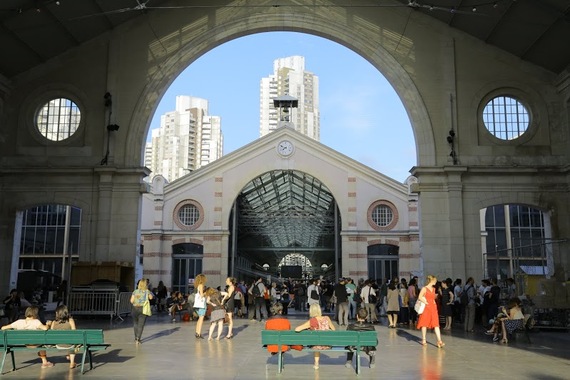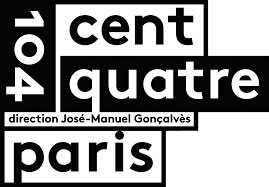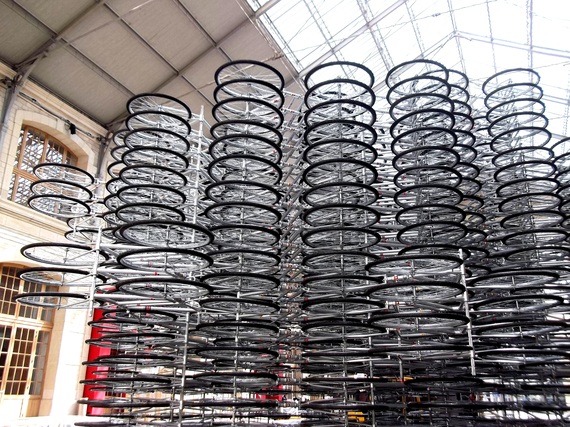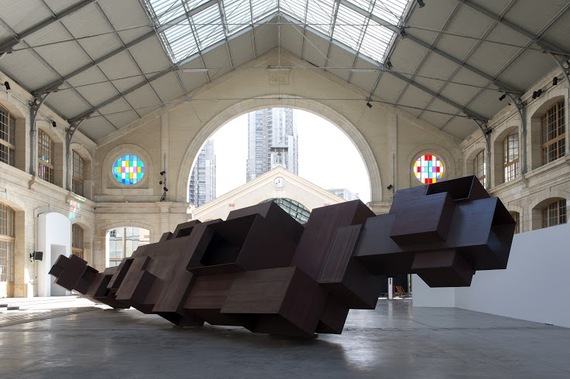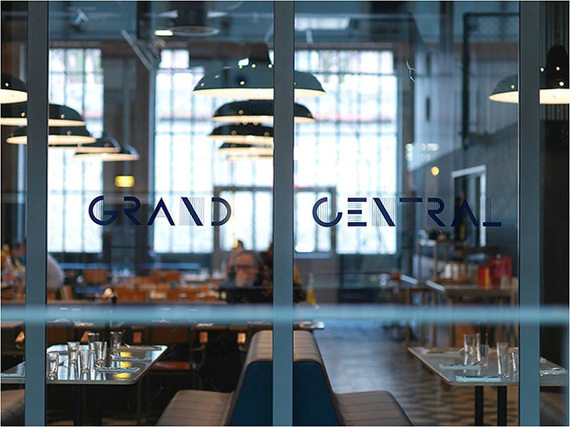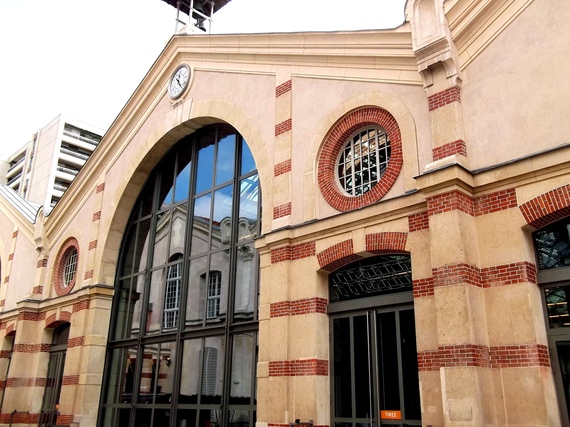Art Galore.
The 104, as it is called, spelled out in French as Le Centquatre-Paris, is a multimedia art center partly funded by the city of Paris. Located in a vast compound of gigantic halls and structures, it houses dance floors, exhibit halls, stores, libraries, workshop classes and stages. Calling itself an artistic and cultural factory, the place is geared towards public service -- Art as a public service is definitely a great concept!
On any given day a buzz of artists, dancers, yogis, actors, painters, sculptors, fill the cavernous space with laughter and life. Visitors pop up at the arts library, shoppers stroll through the Emmaus thrifstore. It's at the same time neighborhoods hang-out for young skaters, and an elite art space for openings and happenings.
Its success is real and tangible. You can witness art in various forms glow right under your eyes, and see how art really is a street expression in its best form. Over 60 percent of the performing artists at the 104 are not French.
The fall schedule of exhibition is heavy with many new shows coming up: dance performances, visual arts, circus acts, theater and music fests. Solo acts or ensemble pieces, no matter what month you are able to go, several art forms will be on display or happening, including a ball in April open to all. About 50 artists in residence are planned to offer their creations for the 2015-2016 season.
An official opening was held Sept. 26 to present the 25,000 square feet of available galleries and open spaces to the public for the new season. On Oct. 3, a Nuit Blanche (White Night) is planned, when the space will stay open all night. The calendar is so full of events that it would be impossible to see and hear everything offered to each senses.
Les Pompes-Funèbres : From Death to Life.
Located on the site of a former municipal undertaker, the name comes from the original entrance's address, at 104 rue d'Aubervilliers. This was not the mom and pop funeral home where one would visit one deceased family member in a flower-filled room and weep. This was where hundreds of horse-drawn hearses used to park and be maintained. Now an artistic factory, it churns out events and gatherings at a vertiginous speed.
The buildings were erected in 1873 by the diocese, ruled by religious staff; later on, with the separation of state and church, the city created in 1905 the Service municipal des pompes funèbres (Municipal Service of Funeral Process), considered at the times as a liberal progress, as it meant that from then on, regardless of religion or condition, everyone was due a proper funeral.
Before that, divorced women, suicide victims, atheists, all were to be buried at night without any dignified ceremony or family members present. The municipal monopole was taking care of everything, from coffins to hearses, from porters to cemeteries. One of the important rituals after a death was to wrap the front door of the building where the deceased laid with massive black curtains on each side of the front door - those were called the pompes.
This black veil was used until the 1980s. The Municipal Monopole was still in practice until the middle of 1997. Since then, the ceremonial is now left to family and private companies.
At the Pompes Funèbres, 27,000 hearses were in use, with a staff of 1,400, only forty of which were women. Carpenters, wood workers, steel workers, mechanics, auto body specialists, seamstresses, cooks for the on-site workers' cafeteria. Civil servants, horse caterers and other employees were lodged on the premises. There was even a football team, musicians, and firefighters dedicated to the ensemble of constructions. The funeral parlor did not handle corpses - that was done in private parlors. Except in times of war, when the bodies of soldiers were given back to their families.
Creativity at its Best.
So the place was truly always alive (pun intended) in a way, but for some 15 years when it was closed down, before the re-birth as an art center in 2008. When I last visited at the beginning of September, I saw several artists using the multi-levels center floor as a dance stage and yoga space, kids running around huge sculptures, workers having a sandwich on beach chairs, the feel of community involvement was very tangible.
At each end of the space giant art pieces jetted to the open sky - this is a place that could easily accommodate one of Louise Bourgeois giant spider sculptures. Not every art space can. An enormous funky piece made of hundreds of bicycles wheels and frames in a sculpture by Chinese Al Weiwei named "Stacked" was taking one end of the forum - representing the transportation mode of his native country, while a metal snake of rust-color boxes was being installed for the upcoming vernissage.
Concerts for all ages and all style are planned for the fall schedule. Several art shows will also open at the various venues encompassed in the buildings. It's a real artistic community all housed under one roof. A glass roof that is.
The architecture is reminiscent of the former market halles (market halls) that were once famously popular in the center of the capital. Why waste beautiful edifices? The eco friendly turn-around of the classic buildings is a testament of the creativity of its new users, all artists.
Side Shows.
A food truck selling pizzas is permanently parked inside the Centquatre. The Emmaus store resales clothes and furniture pieces at very low prices, and involves members of the community to work there. Canvas beach chairs invite people to lounge at will. Several corners are meant to be used as sitting areas, or even picnic settings.
The café's menu is full of childhood favorites, such as toasts, soft eggs, fries and milk-shakes. It is named the Café Caché (the Hidden Café). Another resting place for food is the Grand Central restaurant, the loft-like space offering traditional French dishes at a medium range price - think sausage and lentils, beef cheeks, mussels and fries, rabbit with granny smith apples, steak with Béarnaise sauce, etc..
The CentQuatre had a challenge -- to fill the enormous spaces spread on several city blocks, and despite its sheer size, the place works -- it is both a community haven and a convivial space for all. Despite being located in an untrendy area of Paris, that has not stopped Parisians of every corner to make the trip for the sake of art. Over half a million visitors/spectators came by last year. Bravo!
If you go:
Le CentQuatre is at 5 rue Curial, Paris 75019.
Open Tuesday-Friday noon-7 p.m. Weekends 11 a.m.-7 p.m. Closed Monday.
Métro stop: Riquet.
Bus 54 or 60.
http://www.104.fr/english/

